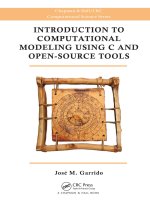Open Source Firewalls
Bạn đang xem bản rút gọn của tài liệu. Xem và tải ngay bản đầy đủ của tài liệu tại đây (333.25 KB, 24 trang )
Open Source Firewalls
Overview
This chapter could also be titled "How Hackers Protect Themselves." Hackers have computers too
and want to keep their own machines free of intrusion from the Internet. Paradoxically, these
computers may be the most secure computers on the Internet, because the hackers use free
software that they can examine for security problems, they are the first to discover (or create)
security weaknesses, and they fix their own systems as soon as loopholes are discovered. They
share the security fixes with anyone who wants them, and you can take advantage of this fast
response to new threats in your own network by using the same software they do.
There are several free software packages that you can use to craft a firewall for your network. Most
of these packages run on free operating systems such as Linux, BSD, or DOS. We'll examine
several popular packet filtering packages—IPChains or IPTables for Linux, Drawbridge for−
FreeBSD, and ipf for OpenBSD. For proxying we'll check out the Squid web proxy and the Trusted
Information System's Firewall Toolkit (TIS FWTK). Finally, for those averse to multitasking, we'll
look at IPRoute on top of DOS.
Free firewalls often suffer from a few of the same class problems:
• Weak or missing logging and alerting features
• No real time firewall monitoring capability−
• Weak or missing graphical user interface
• Difficult command prompt based configuration−
These problems all stem from the fact that the software is developed primarily by a single individual
or small team rather than by a corporation. Small teams don't have the time or money to spend on
ancillary problems like ease of use or sophisticated alerting and logging mechanisms. These
features, when present, are nearly always provided by an add on package developed by a different−
developer. Free software is developed for people who deeply understand the problem to be solved
and the operating system upon which the software runs.
With network security being a strong point but ease of use being a weakness of these free− −
packages, several companies have built businesses around "finishing" the free firewalls and selling
the result. If you look closely, you'll find that under the hood of many of the commercial firewalls
reviewed later in this book lurks a Linux or BSD kernel running IPChains or ipf. For plug and play− −
security that may be the better solution, but if you're not afraid to roll your own firewall, then this
chapter's for you.
Linux and IPChains or IPTables
Linux is an Internet phenomenon that baffles many people in the traditional computer software
industry. Linux was an educational project of a Finnish college student named Linus Torvalds that
has gone much further than originally expected. Using free software tools developed for Richard
Stallaman's GNU (Gnu's Not Unix) project, he wrote a simple operating system for his computer
because he didn't like DOS and Windows, and nothing else was available for which he could get
source code. He posted his code to the Internet and other people got interested, suggested
changes, and (most importantly) sent their own additional code back to Linus to extend the little
operating system. Now the little operating system is as fully complex and powerful as Windows NT
314
or traditional Unix, and all of the source code is still available for anyone to browse, change, and fix
for security problems.
NoteThe biggest security advantage to Linux, according to Linux advocates, is that once a security
problem in the operating system is understood, it can be diagnosed and fixed in hours or
minutes, and a security patch will be posted to the Internet minutes later. Software or detailed
instructions for stopping any intrusion threat is typically made available through security
newsgroups and websites within a day of the threat being found. Contrast this to the time it
usually takes commercial operating system companies to acknowledge a security problem,
prepare a work around, and then deliver an operating system update (hint: it usually takes−
longer than a day).
A significant addition to the Linux core operating system is the ability to perform packet filtering and
Network Address Translation in the operating system itself. Originally called IP Masquerade
because of its NAT ability, the system is now called IPChains or IPTables (depending on the version
you're using—both are present in current distributions and either or both can be used), because it
allows the administrator to set up chains or tables of rules that a packet must satisfy when it arrives
at the Linux computer, is routed within the computer to another adapter, or exits the computer to
another network.
IPChains and IPTables provide NAT and packet filtering. Protocol inspection must be provided by a
higher level service. TIS FWTK (described later in this chapter) is an excellent proxy server−
package that interoperates well with IPChains on Linux, as well as with ipf for OpenBSD. Another
less complete but easier to install for Linux option is to use Squid, which is a good HTTP proxy.
Other stream based protocols (such as SMTP, NNTP, POP, and DNS) can just be redirected to−
other computers using IPChains, which redirects socket connections according to rule sets you
define but does not examine the redirected stream to ensure that it is in fact an SMTP, NNTP, POP,
or DNS transaction.
Major Feature Set
Linux with IPChains or IPTables supports the following major features:
• Packet filtering rules are applied to every packet as it arrives, transits the Linux routing−
stack, and exits. IPChains is stateless; IPTables is stateful. This is the primary functional
difference between them.
• Proxies may be established by protocol specific content filters provided by higher level− −
services such as TIS FWTK, Apache, or Squid.
• Network Address Translation (dynamic or static) is performed for packets transiting the
routing stack to hidden, internal networks.
• DMZs can be established either by filtering access to an externally visible protected
subnetwork or by redirecting virtual public addresses to address translated protected hosts.−
• VPN firewall to firewall and firewall to remote client options are provided as additional− − − −
Linux components that can be downloaded from the Internet at no cost.
• Port redirection is natively provided by IPChains and IPTables.
• Clever use of IPChains or IPTables with Squid or FWTK can give you transparent proxies.
• Linux with FWTK easily gives you reverse proxies (HTTP, SMTP, FTP, etc.) as well.
• Linux with installable packages such as PoPToP or FreeS/WAN gives you platform generic
VPN options (PPTP, IPSec, etc.)
• Additional packages convert the regular Linux syslog reporting system to store logging
information to databases and give you e mail notification.−
315
Minor Feature Set
Linux with IPChains or IPTables supports the following minor features:
• Performance of Linux packet firewalling is fast because standard desktop processors are far
faster than the processors used in most dedicated firewalls, and because Linux doesn't have
nearly as much networking overhead as most general purpose operating systems. Since it is
integrated with the Linux IP stack, the packet filter avoids the overhead of other firewalls that
are implemented as user level programs. This solution can easily handle a busy LAN−
connection to the Internet even with Network Address Translation enabled.
• Command line based configuration requires more skill in administration, but allows you to−
store policies in text files and use scripting tools for dynamic policy management. Many
Linux distributions provide a graphical interface that drives the command line programs,−
making the software easier to set up and configure.
• Remote management (using a secure shell (SSH) or a web interface) allows you to manage
your firewall from other computers in your LAN.
• The packet filtering rules allow you to use NAT and forwarding for sockets to redirect traffic−
for particular services (such as HTTP, SMTP, and POP) to protected internal servers.
Security
Linux filters packets before they are delivered to the IP stack for processing, allowing you to protect
your computer from malformed packets and other IP level attacks. Linux provides the full range of−
options for packets filtering on: the SYN bit, source and destination IP addresses, source and
destination ports, packet type, and most other TCP/IP header data elements. Network Address
Translation is built into the packet filter, so you can use the same rules to specify the kinds of
packets that will be translated and the kinds that will not.
Since Linux does not inspect the data portions of the packets it manipulates, you will need a proxy
server to ensure that the traffic traversing a particular port conforms to the protocol for that port (that
only HTTP requests and replies are going over port 80, for example). See the sections on Squid
and the TIS FWTK package later in this chapter. Also, many web servers will also act as HTTP
proxies, and you can use servers for store and forward protocols (such as SMTP and NNTP)− −
without modification as protocol proxies for their services. Ideally, you will run these services on a
different computer than your firewall, and you will use address translation to redirect the appropriate
traffic to and from these servers.
The Linux filtering software evaluates every packet received by the network adapters in the firewall
computer according to a set of rules you established when you installed the software. The rules are
applied in order, one at a time, until the filter finds a rule that matches the packet and specifies a
terminal action, such as ACCEPT or DROP. Since the rules are applied in order, it is vitally
important to craft the rules in the right order.
A useful feature of IPChains (and the feature that gives it its name) is the bundling of sets of rules
into chains. IPChains starts out with three—INPUT, FORWARD, and OUTPUT. You can establish
additional chains and use a rule in INPUT, FORWARD, or OUTPUT to direct packet analysis to the
appropriate chain for that type of traffic. This structured rule management makes it easier to reason
about the security of the firewall and thereby makes it easier to secure the firewall. IPTables works
similarly, but provides stateful inspection.
316
Interface
Linux packet filtering is administered using the ipchains or iptables command, which takes as its
arguments the rules to be established or modified in the packet filter. Figure 16.1 shows an example
of the IPChains command line syntax.−
Figure 16.1: IP Chains command line interface−
Most network administrators who use IPChains create shell scripts to configure the packet filter. The
Example IPChains Shell Script sidebar shows you an example of an IPChains packet filter
configuration.
Example: IPChains Shell Script
The following example creates a simple, permissive filter policy:
#!/bin/sh
ipchains F−
ipchains A input p icmp icmp type destination unreachable − − −− − − −
j ACCEPT
ipchains A input p icmp icmp type source quench j ACCEPT− − −− − − −
ipchains A input p icmp icmp type time exceeded j ACCEPT− − −− − − −
ipchains A input p icmp icmp type parameter problem j− − −− − − −
ACCEPT
ipchains P forward REJECT−
ipchains A forward j MASQ s 10.5.5.0/24 d ! 10.5.5.0/24− − − −
317
ipchains A input i lo j ACCEPT− − −
ipchains A input i eth0 p TCP d 24.0.148.207 81:519 j DENY− − − − −
ipchains A input i eth0 p UDP d 24.0.148.207 81:519 j DENY− − − − −
ipchains A input i eth0 p TCP d 24.0.148.207 530:1024 j− − − − −
DENY
ipchains A input i eth0 p UDP d 24.0.148.207 530:1024 j− − − − −
DENY
echo 1 > /proc/sys/net/ipv4/ip_forward
Most network administrators would prefer a more graphical and intuitive way to administer their
firewall rules, however. Commercial Linux distributors, such as Storm Linux, have bundled graphical
management utilities for firewalling and other functions in order to provide extra value to their
distributions that you couldn't get from free software. Figure 16.2 is a view of the Storm Linux
graphical firewalling tool. The free software isn't far behind, however, and in many cases may be
ahead in usability now that they've completed the behind the scenes firewall piping to their− −
satisfaction. They're busy polishing the knobs and buttons to make it easy to use and still free to
download, as the Gnome firewall configuration tool in Figure 16.3 illustrates.
Figure 16.2: The Storm Linux graphical interface to IPChains
318
Figure 16.3: The Gnome graphical firewall administration (included in Red Hat Linux 7.2)
Documentation
IPChains and IPTables are documented in the typical Unix manner—readme and install files come
with the software installation package (which may already be installed on your Linux system) and
documentation of those command line tools can be found from the man (manual) command.−
Tip You can find step by step instructions for installing IPChains on the Internet; just search on− −
IPCHAINS from any search engine. Information on IPTables can be found at its site:
/>Cost and Support
You can find many versions of Linux distributed at no cost. You can also purchase it from several
different vendors, including the very popular Red Hat, but you don't have to buy even those copies
more than once. Install it on as many servers as you feel like, and protect as many clients as you
want. The biggest costs for using Linux are the cost of the computer used to run it and the cost of
the time spent by you or the administrator to configure and manage it.
Minimum platform requirements for Linux are easy to meet and should not be expensive:
• A distribution of Linux with IPChains or IPTables
• 486 processor or better, including any processor architecture for which a version of Linux
exists
• At least two network interfaces
• 200MB of disk space
• 32MB RAM
The Trusted Information Systems Firewall Toolkit (TIS FWTK)
The TIS FWTK is the granddaddy of freely available firewalls. You can download versions for Linux,
NetBSD, Solaris, as well as just about any other flavor of Unix you can think of. If you need a
319
firewall and you have a spare Unix workstation collecting dust in a corner, this may be the firewall
for you.
FWTK was created for the Defense Advanced Research Projects Agency (DARPA) by TIS when
DARPA realized that no packet filter would be secure enough to filter protocol content. After fulfilling
the terms of their contract with DARPA (which includes making the code public domain), TIS further
extended the firewalling concept into a commercial suite known as the Gauntlet Firewall. TIS was
acquired by NAI recently, making Gauntlet Firewall a component of the PGP Active Security Suite.
FWTK is now maintained by an Internet consortium at />FWTK is not a packet filter. Instead it comes with protocol scrubbing proxies for Telnet, Rlogin,−
SMTP, FTP, HTTP, and X Windows. In addition, it comes with a generic TCP passthrough−
redirector (a SOCKS proxy). FWTK also extends its security controls into the Unix LAN
environment, providing centralized network login and resource control using the netacl and authserv
utilities.
Major Feature Set
FWTK supports the following major features:
• Protocol specific content filters are provided by included proxy components.−
• Centralized network login and resource access control for Unix computers is maintained
using the TIS security mechanisms.
Minor Feature Set
FWTK supports the following minor features:
• Performance of FWTK is relatively fast.
• Command line based configuration requires more skill in administration, but allows you to−
store policies in text files and use scripting tools for dynamic policy management.
• Remote management using secure shell (SSH) or a web interface allows you to manage
your firewall from other computers in your LAN.
• Address Translation and forwarding for sockets are performed using the FWTK generic TCP
plug board.−
Security
FWTK does not filter packets before they are delivered to the IP stack for processing. You must use
some other package to protect your computer from malformed packets and other IP level attacks−
(IPChains for Linux or ipf for OpenBSD are good choices).
FWTK is a proxy server; it examines the data portions of IP packets to ensure that the traffic
traversing a particular port conforms to the protocol for that port (that only HTTP requests and
replies are going over port 80 for example). This ensures, for example, that a hacker doesn't use
port 80 to access a Trojan horse with its own protocol because your packet filter allows packets in
the network to port 80 for HTTP services.
FWTK evaluates data received by the network adapters in the firewall computer according to a set
of rules established in its net perm rule table. The rules are defined according to the port to which−
the data was sent, while permissions are defined according to the source and destination of the
data.
320
Interface
You enable FWTK by replacing the services to be proxied in the inetd.conf (or equivalent service
configuration file for your operating system) with the corresponding FWTK filter for that protocol (see
"Example FWTK Configuration Entries" in the following sidebar).
Example: FWTK Configuration Entries
This example creates the files indicated containing the text listed after the file.
/etc/inetd.conf
### standard config:
#ftp stream tcp nowait root /usr/sbin/tcpd /usr/sbin/
wu.ftpd
#telnet stream tcp nowait root /usr/sbin/tcpd /usr/sbin/
in.telnetd
### firewall config:
ftp stream tcp nowait root /usr/local/etc/netacl wu.ftpd
telnet stream tcp nowait root /usr/local/etc/tn gw tn gw− −
www stream tcp nowait root /usr/local/etc/http gw−
httpi gw−
netperm table−
# netacl rules:
# −−−−−−−−−−−−−−−−−−−−−
# local FTP users connect to proxy ...
netacl wu.ftpd: permit hosts 192.168.* exec /usr/local/etc/− − −
ftp gw−
# ... while foreigners may use anonymous FTP
netacl wu.ftpd: permit hosts * exec /usr/sbin/wu.ftpd− − −
# ftp gateway rules:
# −−−−−−−−−−−−−−−−−−−−−−−−−−
# only local users may use FTP proxy
ftp gw: timeout 3600−
ftp gw: denial msg /usr/local/etc/ftp deny.txt− − −
ftp gw: welcome msg /usr/local/etc/ftp welcome.txt− − −
ftp gw: help msg /usr/local/etc/ftp help.txt− − −
ftp gw: permit hosts 192.168.* log { retr stor }− − −
321
# telnet gateway rules:
# −−−−−−−−−−−−−−−−−−−−−−−−−−−−−
# only local users may use Telnet proxy
tn gw: timeout 3600−
tn gw: denial msg /usr/local/etc/tn deny.txt− − −
tn gw: welcome msg /usr/local/etc/tn welcome.txt− − −
tn gw: help msg /usr/local/etc/tn help.txt− − −
tn gw: permit hosts 192.168.*− −
# http gateway rules:
# −−−−−−−−−−−−−−−−−−−−−−−−−−−−−
http gw: deny hosts unknown− −
http gw: permit hosts 192.168.*− −
http gw: permit hosts * httpd www.mybiz.com− − −
# smap and smapd rules:
#−−−−−−−−−−−−−−−−−−−−−−−−−−−−−−
smap, smapd: userid 20
smap, smapd: directory /usr/local/var/spool/smap
smapd: executable /usr/local/etc/smapd
smap: maxbytes 2097152
smap: maxrecip 4000
smap: timeout 3600
The FWTK proxies read their configuration from the net perm table, which describes for each−
protocol those hosts (source and destination) that are allowed to use the proxy. The Example FWTK
Configuration Entries sidebar shows sample configurations for FTP, Telnet, and HTTP.
IPChains is administered using the ipchains command, which takes as its arguments the rules to be
established or modified in the IPChains packet filter. Its syntax is described in the previous section.
Documentation
FWTK is documented in the typical Unix manner—readme and install files come with the software
installation package (which may already be installed on your Linux system) and documentation of
the FWTK commands can be found from the man (manual) command.
322









